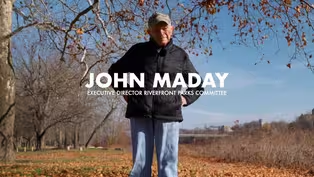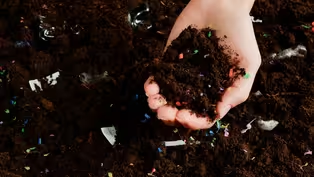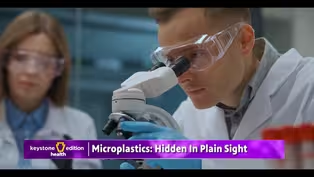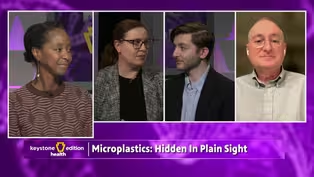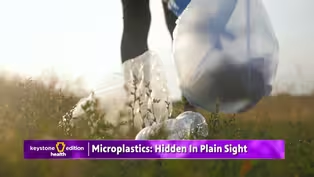Keystone Edition
Microplastics: Hidden in Plain Sight
12/16/2024 | 26m 59sVideo has Closed Captions
Support for Keystone Edition Health comes from the Robert H. Spitz foundation.
Microplastics are extremely small pieces of plastic debris in the environment resulting from the disposal and breakdown of consumer products and industrial waste. These microplastics have been implicated in cardiovascular disease, respiratory disorders, insulin resistance, and cancer.
Problems playing video? | Closed Captioning Feedback
Problems playing video? | Closed Captioning Feedback
Keystone Edition is a local public television program presented by WVIA
Keystone Edition
Microplastics: Hidden in Plain Sight
12/16/2024 | 26m 59sVideo has Closed Captions
Microplastics are extremely small pieces of plastic debris in the environment resulting from the disposal and breakdown of consumer products and industrial waste. These microplastics have been implicated in cardiovascular disease, respiratory disorders, insulin resistance, and cancer.
Problems playing video? | Closed Captioning Feedback
How to Watch Keystone Edition
Keystone Edition is available to stream on pbs.org and the free PBS App, available on iPhone, Apple TV, Android TV, Android smartphones, Amazon Fire TV, Amazon Fire Tablet, Roku, Samsung Smart TV, and Vizio.
Providing Support for PBS.org
Learn Moreabout PBS online sponsorship(bright music) - [Presenter] This program is made possible through support from the Robert H Spitz Foundation.
- [Presenter] Live from your public media studios, WVIA presents Keystone Edition Health, a public affairs program that goes beyond the headlines to address issues in northeastern and central Pennsylvania.
This is Keystone Edition Health.
And now moderator Tonyehn Verkitus.
- Good evening and welcome to Keystone Edition Health.
I'm Tonyehn Verkitus.
Thank you for joining us tonight.
Being invisible to the naked eye microplastics are everywhere across our planet from the food we eat, the waters we drink, to the air we breathe.
But what does this mean to our health?
Some studies indicate that microplastics may carry toxic chemicals or that they may cause inflammation.
While research is consistently being looked into on these matters and more dealing with microplastics.
Tonight we'll be going into how you, your family, and others can protect yourselves.
But first WVIA's Haley O'Brien has more.
(logo whooshes) - [Haley] Broken down from larger plastic items like bottles, bags, and even clothing microplastics are located in everything causing a global issue.
Once inside our bodies, the impacts aren't fully understood yet, but there's growing concern about their potential to cause harm.
According to the National Library of Medicine, microplastics can interfere with the production, release, transport, metabolism, and elimination of hormones, which can cause endocrine disruption and lead to various endocrine disorders, including metabolic disorders, developmental disorders, and even reproductive disorders.
The biggest concern is that plastics can carry toxic chemicals like pesticides and heavy metals into our bodies.
Ways of preventing microplastics from entering our bodies are buying organic food and drinking filtered water, and using glass, stainless steel and other natural materials instead of plastic bottles and containers.
For WVIA News, I'm Haley O'Brien.
- Joining us tonight, we have Dr. Adriana Dinescu, Assistant Teaching Professor of Chemistry at Penn State Wilkes-Barre.
Faran Savitz, Zero Waste Advocate for PennEnvironment.
And joining us remotely, we have Edward C. Katyer, Medical Advisor for Environmental Health Project, and President of Physicians for Social Responsibility, Pennsylvania.
Thank you all for joining us.
I think this is going to be a pretty interesting topic for folks.
It may also be slightly alarming, but we'll try to keep it not too dangerous.
I'm hoping that you could start by telling us exactly what microplastics are.
- Yeah, so there are different types of molecules that we use for making plastics, and most common ones are polyethylene and polypropylene.
Now, the plastics themselves are not toxic.
However, there are more than 10,000 chemicals that are used with plastics just to give a certain appearance, a certain rigidity, a certain resistance to UV light or a certain resistance to high temperatures.
And we kind of don't know exactly if we have a piece of plastic, what chemicals are going to be in the plastic itself, but we know that there are some.
And we also know that there could be heavy metals, could be endocrine disruptors.
There are phthalates who are also kind of, you know, in a similar way, they disrupt our hormonal system and also they cause inflammation.
Now what is the microplastic?
It's a small piece of plastic because usually plastics are not going to degrade easily, but they can be broken down in very, very small pieces.
And microplastic could be now as small as five millimeters.
That is about a fifth of an inch.
- [Tonyehn] Okay.
- But can be as small as one nanometer, which is more than one million times smaller.
So those are the microplastics that are more dangerous.
So therefore, if we see the size or the part of the microplastic, that is not dangerous.
Even if we ingest that, it's going to be eliminated.
But if it is one nanometer, which is very, very tiny, it's the size of an atom, then can be a problem.
- Okay.
Ned, there's all these microplastics out there.
Can you tell us how they're getting into people's systems?
- Well, they are getting into us when we ingest these microplastics in our food and our water.
They also get in us when we breathe the fibers and other types of microplastics and nanoplastics that are airborne and they come in contact with our skin.
A lot of products that we use for our skin, cosmetics and so forth, contain microplastics and so they get on our skin.
So inhalation, ingestion, and dermal contact.
- I think it's interesting that we all use these exfoliants.
And I don't think I ever thought about the fact that those are tiny little plastic beads in there.
I know your work, Faran, is a little bit different because you're doing this Zero Waste program.
Can you tell us a little bit, A, about what PennEnvironment does and then the Zero Waste program as well?
- Sure.
So at PennEnvironment, we're a statewide nonprofit.
We work to make sure Pennsylvanians have clean air, clean water, and a livable environment.
In our Zero Waste program, we really focus on the idea that we have a lot of stuff, and a lot of that stuff we use for a couple minutes and then we throw it away and don't think about it.
But especially with plastic products, when we throw it away, whether it goes to a landfill, an incinerator, if it gets recycled or littered straight in our environment, it can be causing harm to our wildlife, our environment, and our health too often through these microplastics, because a plastic bag, a plastic bottle, if it's in a landfill, it could be breaking down into microplastics that get picked up in the air that leach into our waterways.
An incinerator could blow tiny pieces of microplastics around the state, around the country.
So we've spent a lot of time testing waterways all around Pennsylvania, over a hundred to date for these microplastics to see is plastic just an ocean problem or is a problem for our lakes, our streams, our rivers, the local waterways we love and care about.
And unfortunately we found microplastics every single waterway that we've tested.
- Yeah, I heard recently that they are something like 20 million tons of plastics going into the Great Lakes each year, which is amazing.
- It's a staggering amount because we just use so many of these plastic products and don't really think about it.
But they do have repercussions.
They last for hundreds of years, if not longer in our environment.
And as we heard, they don't really go away.
They're just getting smaller and smaller and smaller.
And the smaller they get, the easier it is for them to travel around and pollute our waterways, our wildlife, and eventually work their way into our bodies too.
- Ned, we're talking about ingesting these microplastics.
Once they enter our bloodstream, our lungs, et cetera, A, are they leaving our system?
And B, what types of repercussions are there?
- So the plastic particles themselves, the microplastics and the nanoplastics have worked their way into practically every organ that researchers have looked at.
Now, if they're big enough and we ingest them, we will excrete them in the feces.
But if they're small enough, especially the nanoplastics, they tend to remain.
But the biggest problem I think, in addition to the plastics in our body are the chemicals that are not bound to the polymer, to the plastic that will leach out of these small plastic particles into our bloodstream.
Some of those chemicals, phthalates, parabens, PFAS chemicals, they accumulate in our bodies over time.
The body had the ability to get rid of some of these chemicals, but the question is, can it get rid of all the chemicals?
These chemicals work in our systems, on our bodies, particularly affecting our hormones at extremely small concentrations.
So even if the body can get rid of most of the chemicals, it doesn't take very much to cause harm to our bodies.
- You spoke about the chemicals earlier as well as a chemist, can you tell us whether or not when we buy a BPA free bottle for instance, are we doing something good for ourselves or not really?
- I think it's just like lottery.
You may be lucky and maybe the chemicals that are in that plastic are not dangerous.
Even though from those, you know, more than 10,000 chemicals about 7,000, I guess, they're considered having a potential hazardous effect.
So it's potential.
Again, we don't know.
And from those about 3000, they kind of have, you know, some harmful effects for our health.
So that's why we kind of don't know, even if it's written BPA free, it's going to have other chemicals and it's very likely that instead of a BPA, there is something similar to BPA that is going to cause exactly the same effects.
So that's why I think it would be best that if more regulation would be imposed on plastics or at least more transparency.
Because if someone would list exactly the producers and the industry would at least all of the additives and all of the chemicals that are added into that plastic, then we could actually make a choice when we purchase those.
- Recently, WVIA's Tim Novotny met with John Maday, executive director for the Riverfront Parks Committee.
He shared with us how microplastics first enter our water systems and how we can come together to prevent this in the future and work as a community to currently clean our water systems.
(logo whooshes) (water gurgling) - [John] Microplastics in the water have increasingly become a problem.
By 2050 there will be more plastic containers pieces by volume than fish in all the oceans of the world.
(gentle somber music) Anything that's thrown here, high water event, it's gonna end up in the river.
You could be so far removed from here, you could be say in mountaintop or in the back mountain, anything around there will get caught up and end up say in another stream that will end up in the river.
So that's one of the reasons we do this type of work.
My name is John Mayday.
I'm the volunteer executive director for the Riverfront Parks Committee.
Well, what we're walking through here is one of my favorite places 'cause it overlooks the river and it overlooks the Market Street Bridge.
You'll notice some of these trees that are planted here.
We planted that these through here during some of our Earth Day events.
(gentle music) - Howdy.
- Hello.
- Doing a little fishing.
- Yeah.
- Good.
You know, when I come down here, when I'm down through here, when we do our cleanups, I'm always reminded of that first day we were here, when I was here, you know, all these many years back in 1990 or so when we had all that trash here, and you know, the major cleanup, 3, 400 bags.
And now look where it is today.
It's really changed.
(gentle inspiring music) 35 plus years ago, when we walked from the arches of the Market Street Bridge down towards the Olmstead Trail, we picked about 400 bags of trash.
Over time that has diminished.
And that's to the work of all these volunteers.
35 years ago, people would say it's a dump.
Look at it today, it's pristine.
And that's because people became involved and helped out and worked at it.
People will come down here, say late at night, and dump stuff.
Some people will just dump bags of trash.
This is ending up in your food source.
The other thing is, animals and fish think they're food, they eat them, they can't digest, they die.
If we don't act now, microplastics will keep breaking down and spreading, ending up in our rivers and into our oceans.
But by coming together, we've shown that we can make a difference.
When you're doing something, think about the impact of what it is you're doing, the consequences of your decision and how you can make a difference.
(logo whooshes) - Faran, I think this is a great transition to talk about your program.
Can you tell us a little bit about this community driven science program where you were collecting samples of water?
- Sure.
So our work testing for microplastics is really a citizen science driven program 'cause a lot of our work at PennEnvironment focuses on advocacy, on solutions, on trying to create the policy changes.
But our microplastics work, we know that Pennsylvanians care deeply about their rivers and streams.
It's where we fish, it's where our kids play, it's where we boat.
They're sort of the lifeblood of our communities.
And so we did this citizen science project where our staff, our interns, our volunteers went out and collected water samples from all around the state.
We involved local fishing groups and recreation groups.
We got state and federal officials to come out and test waterways with us.
And then we took those samples back and we filtered them and analyzed them for microplastics.
And it's a great way to really get people to connect with this problem of plastic pollution.
'Cause a lot of times we think about it as a litter problem, as a problem maybe for sea turtles and whales, but when we really see the plastic pollution at home in the waterways that run through our yards or that we walk along every day, it connects us to them and makes it that much more important that we do strive for some of these solutions to actually work upstream and tackle the sources of plastic that are becoming microplastics and polluting these waterways too.
- Yeah, I think when you personalize then it gives me or Andrea a responsibility, right?
- [Faran] Of course.
Yeah.
- Ned, as the president of Physicians for Social Responsibility, Pennsylvania, you're obviously not just looking at plastics, but where these plastics come from.
Can you speak to us a little bit about that?
- Well, the life of plastics begins at the wellhead where oil and gas is fracked.
And here in Pennsylvania there's an awful lot of fracking going on, especially where I live in southwestern Pennsylvania.
Ethane and methane are the gases that are fracked out of the ground.
The ethane is cracked at an ethane cracker facility like the Shell Plant in Beaver County, Pennsylvania, which is an enormous plant.
Ethane is cracked into ethylene and then that's polymerized into polyethylene pellets, which are small plastic pellets or nodules that are then sent to plastics factories to make new plastic products, especially single use plastic.
So that's where plastic is born at the wellhead.
And so there are an awful lot of health problems associated with fracking that we're observing here in southwestern Pennsylvania and in northeastern Pennsylvania where fracking is occurring.
Pennsylvania is a fracking state and that doesn't seem to change or it's not gonna change anytime soon.
But residents of Pennsylvania around fracked gas are getting sick and seriously so.
And we're seeing the same types of illnesses around the cracker plant.
So, you know, from start to end, from its beginning to its end in landfills, in our oceans, in streams, in soil, plastic is very dangerous and is harming health.
- If I could- - Oh, go ahead, please.
- I'll be real quick.
- Absolutely.
- Just to put a finer point on it, it really gives Pennsylvania an extra responsibility when it comes to the plastic that we create and use because really at every step of its lifecycle, from when we extract the chemicals and the fossil fuels from the ground to when we turn 'em into plastic products, to when we use them and then dispose of them, we're creating harm for our environment and our health too.
And not a lot of other states can say that.
And so we really see these problems firsthand and experience them in a lot of other ways that go beyond just the waste.
- Yeah.
We're part of the entire life cycle.
- Yes.
- Unfortunately.
I wanna talk a little bit about end use because we've already spoken about how BPA free basically means nothing, or we won't say nothing, but almost nothing.
But I also wanna talk about how people use plastic in their home because a lot of people are putting it in microwaves, not just storing food in it.
And what happens when you heat plastic or maybe even setting at room temperature.
- Exactly.
Yeah.
So the higher risk is when the plastic is exposed to light, UV light, then you know, then all of the chemicals can leach into, let's say a water bottle.
But also if on the plastic we see that is microwave safe or dish water safe, that means that it has more chemicals in the plastic.
And as we heat or we use very hot water on these, these plastics are going to leach into the water.
And if there is food, it is going to leach into the food.
So we are so used to have use plastics for almost everything in our lives.
And I also want to point out that our clothes are made of plastic, our furniture is made of plastic, so it's not only the plastic that we see, but maybe the plastic that we don't see, or we assume that is not plastic, it's, you know, damaging.
And also I want to point out something else.
We kind of think that the plastic is recyclable and some of it is, but in reality we recycle very little.
So we do our best in our homes to actually, you know, sort that and you know, give it to the recycling company.
But in reality we do not know if that is recycled in the end or not.
- I know that you all work on some policy efforts towards eradicating plastic in our community.
Can you speak a little bit about that and also let people know how they could do similar things in their communities?
- Yeah, we really try and push for upstream solutions when it comes to plastic pollution because yeah, recycling plastic is really, really challenging.
And if it's going to our landfills, it's creating microplastics.
And so the best thing we can do is not create the plastic in the first place.
If we stop it from becoming, if we stop it from getting to consumers, if we stop it from becoming waste in the first place, we don't have to find a sustainable solution.
And so we have seen this work in other states around the country.
One of the best solutions is to pass legislation banning types of single use plastics.
Things like plastic bags, styrofoam containers, plastic straws and utensils.
We use 'em for a couple minutes, we throw 'em away, but they're gonna last for a long, long time and have impacts that go far beyond that.
But they're easily replaceable.
We have reusable and sustainable alternatives that we can turn to instead.
And sometimes it does take that legislative push to get people to start using those reusable alternatives.
We're seeing them more and more in Pennsylvania.
There are now 35 bans on single use plastics across the state, including our two largest cities.
Momentum is building, but it does, it is important for our local communities to step up, stand up and say, we've had enough of plastic waste, it's time to get rid of it.
And the best thing we can do is go with an upstream solution and try and cut it off at the source.
- I heard recently a story about an organization that's actually helping restaurants transition to cardboard and away from plastic.
I wish I'd saved that name so we could say it now.
Ned, as a retired pediatrician, I'm now thinking about the fact that kids always used to drink out of plastic bottles or they had those little plastic inserts that you put in bottles that were disposable.
How do plastics impact a newborn and is it going to be much worse than what would happen to an adult?
- So a lot of these chemicals that are added to plastics act as endocrine disrupting chemicals and they act at extremely low concentrations.
So these chemicals get into the bloodstream during pregnancy, when a fetus is developing, in early infancy and in childhood.
And that's really the most vulnerable time in life is when organs are developing, fetuses and infants are growing and developing, brain development is happening quickly.
And when when you're ingesting or inhaling chemicals that can interfere with your endocrine system, with your hormones, it interferes with the growth and development of growing children.
And so children happen to be extremely vulnerable to these chemicals.
It's not so much that the dose makes the poison, really the timing that makes the poison.
And when you know fetuses and children and infants are exposed to these chemicals, they seem to have the the worst consequences.
- I was wondering, you talked about testing waterways.
Did you all test tap water?
'Cause I can't help but wonder if there might be plastics, microplastics in my water at home as well.
- We have tested tap water samples from a couple different cities, including Philadelphia, Allentown, Bethlehem, and Easton.
Unfortunately, we did find microplastics in our tap water.
These particles are so small that despite all the filtration and water treatment that happens, and despite using maybe a Brita filter or an at-home filter, there's still microplastics that can get through and can get into the drinking water.
That isn't to say you shouldn't drink the tap water.
Certainly if you're drinking bottled water, which is in a plastic bottle, that bottling process is gonna put magnitudes more plastic into your drinking water.
So it's certainly better to stick with tap water to use reusable bottles rather than go with those single use plastic ones if you're gonna avoid microplastics.
But there are still going to be some microplastics that make it in carrying chemicals with them and potentially damaging our health.
- Yeah, after my conversation with you, actually, I was going to buy a Brita filter for my fridge, one of the large ones, and instead I ended up buying glass refillable bottles.
Are there any last recommendations that you would have for folks around plastics in their home and how to avoid them as well?
- Yeah, that's a great question.
So indeed, you know, starting from drinking water, using a glass bottle or you know, stainless steel bottle would be great.
However, there is, we cannot kind of protect ourself from plastic, but we can diminish the amount of the plastic that we breathe or ingest or you know, how much it is absorbed through the skin.
So therefore, I would always suggest, you know, instead of using, you know, plastic utensils or plates or anything that is made of plastic and it is used for as a food container, I would suggest everyone to avoid that.
And by doing so, we also lower the demand on the market.
So therefore there is going to be less produced.
We hope for that.
Other things that we could try, you know, in our clothes, we are going to just to become, not necessarily minimalist, but you know, be more conscious about how much stuff we purchase.
And we don't need that much.
So that's why if we can actually have less and use it more, if we could use, you know, more natural fibers, that would be great.
If we would try to use as furniture, you know, made of wood instead of made of different layers of maybe, you know, small particles of wood and plastics, that would be great as well.
- I love that you talk about that.
It goes right in line with what you were saying about zero waste, and I thank you for sharing that.
Thank you to all of our guests for their insights and to all of you for joining us.
This and every episode of Keystone Edition is available on demand on your YouTube channel.
And now as a special audio podcast, so you'll never miss an episode.
Visit wvia.org/keystoneeditionhealth to stream episodes or subscribe to the podcast.
For Keystone Edition Health, I'm Tonyehn Verkitus.
Have a good evening.
(uplifting music) - [Presenter] This program was made possible through support from the Robert H. Spitz Foundation.
Microplastics and Community Action: Restoring Our Rivers
Video has Closed Captions
Clip: 12/16/2024 | 2m 56s | Explore how you can make a difference for our waterways and planet. (2m 56s)
Microplastics: Hidden in Plain Sight - Preview
Preview: 12/16/2024 | 30s | Watch Monday, December 16th at 7pm on WVIA TV (30s)
Microplastics - Suggestions and Solutions
Video has Closed Captions
Clip: 12/16/2024 | 12m 31s | See a citizen science project testing Pennsylvania waterways for microplastics, (12m 31s)
Uncovering the Dangers of Microplastics
Clip: 12/16/2024 | 8m 21s | Experts explain the dangers of microplastics—tiny plastic particles found in food, water, and air. (8m 21s)
Providing Support for PBS.org
Learn Moreabout PBS online sponsorship
- News and Public Affairs

Top journalists deliver compelling original analysis of the hour's headlines.

- News and Public Affairs

FRONTLINE is investigative journalism that questions, explains and changes our world.












Support for PBS provided by:
Keystone Edition is a local public television program presented by WVIA
